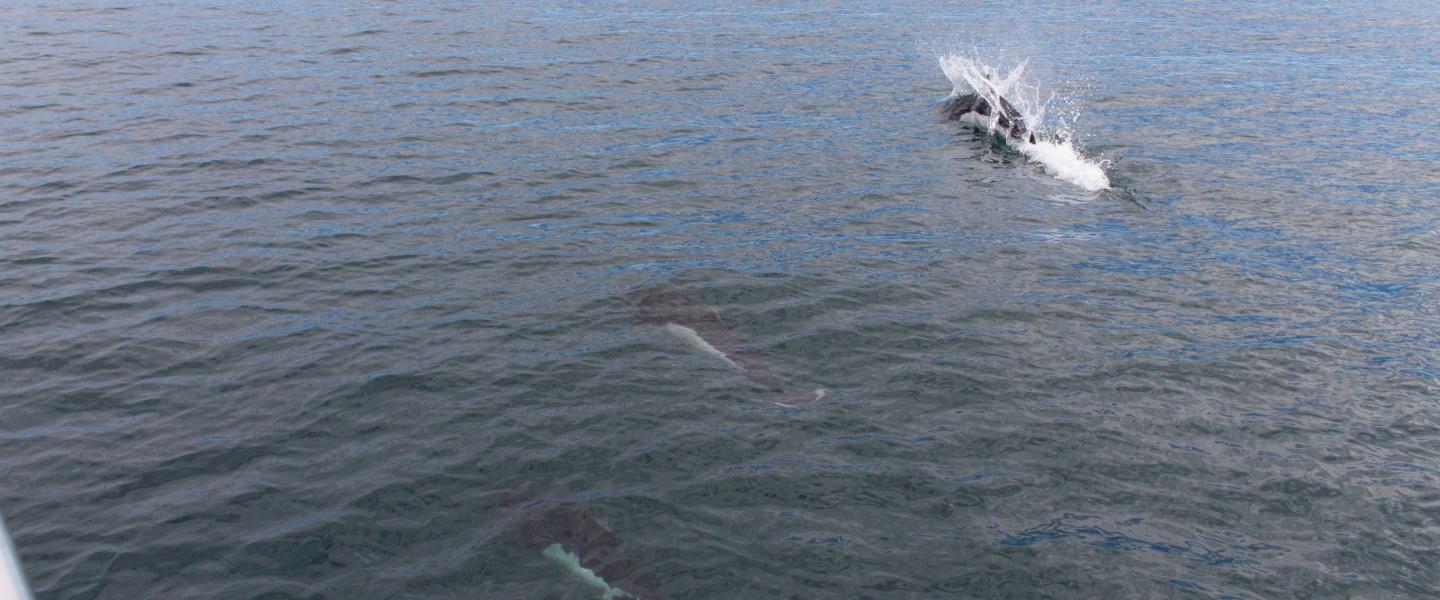
(May 7, 2017) After a couple of weeks of hanging lefts out of Friday Harbor and heading for Canadian waters to watch transient orca, humpback, grey, and minke whales, it felt strange to bear right and run south in San Juan Channel. Such a move often signals that our resident killer whale pods have returned to hunt salmon on the west side of the archipelago, and today was no exception.
Before we reached our destination, we stumbled upon a small pod of Dall’s porpoise. Our experienced captain slowed the vessel to the 7 knot sweet spot and, watching a change in the animals trajectory, I knew we were in for a treat. Dall’s porpoise are the sports cars of whales and they are easily convinced to demonstrate their muscled form and effortless speed when a bulbous boat passes. The porpoises immediately began playing in the wave of water generated by the hull of the M/V Sea Lion. I admired their sharp-looking black and white suits, but was momentarily confused to see a smaller, solid grey individual running with the pack. Then I remembered! Dall’s porpoise are known to occasionally breed with the shy, petite harbor porpoise. We were looking at a hybrid! Harbor porpoise never interact with the boat, so it was remarkable to watch this ugly duckling breaching and swimming at our feet.
Of the three pods of southern resident killer whales, K and L pods usually wait until summer to return to their ancestral fishing grounds in the San Juan Islands. J pod, however, continues to fish the Salish Sea throughout the year, and today we found them near Lime Kiln Lighthouse.
It’s difficult to comprehend, but this unique population of killer whales is on a path to extinction. Thousands of years ago, the resident killer whales made what seemed to be an obvious bet. As the mile-thick ice sheet melted away from the Pacific Northwest, new rivers formed and pioneer Chinook salmon, some weighing in at over 100 pounds, quickly filled them with their progeny. A diverse array of predators showed up to the dinner table, including the group of orcas that would later become the southern resident ecotype, who bound their fate tightly to the seemingly bottomless food source.
But in recent decades, salmon have been disappearing from the coastal streams of Washington, Oregon, and California. Incredibly, the mugs of many subspecies of salmon can now be found next to that of the southern resident killer whale on the list of endangered species. The rapid decline in salmon is driven by several factors, including habitat loss, overfishing, pollution, fish farms and hatcheries, and dams, to name a few. Citizens, businesses, nonprofits and governments are recognizing the critical importance of salmon, not only as a healthy food source for humans and wildlife, but also in sculpting diverse and resilient ecosystems. Obsolete dams, like those that stood in the path of the Elwah River, are being removed, and riparian and estuarine habitat are begin restored as measures to encourage the return of salmon. With the southern resident killer whale population now down to just 78 individuals, proceeding with such restorative actions has never been so urgent.
Andrew Munson
Naturalist, M/V Sea Lion
San Juan Safaris